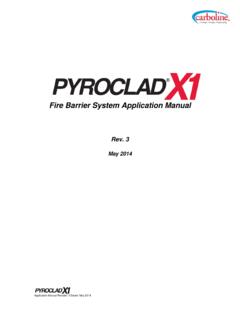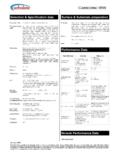Transcription of Objectives - SubratecH GmbH
1 Objectives How passive fire protection (PFP) works Testing and certification requirements for epoxy PFP Main factors that determine PFP thickness Advantages of Pyroclad X1 Estimating a project Sample specification Application methods and equipment How Passive Fire Protection (PFP) Works Why Protect Steel? To protect assets Maintain points of egress for personnel Prevent structural collapse Save lives Why Does Steel Require PFP? Steel looses load carrying capacity as the core temperature increases Steel begins to deform at 427 C (800 F) PFP extends the time it takes to reach the failure point Limiting temperature is project specific (200 C - 600 C / 392 F - 1112 F) Most projects require 400 C limiting temperature Pyroclad X1 Description 100% solids (solvent free) 2 component epoxy PFP Jet fire and hydrocarbon pool fire protection for structural elements, beams, columns, bulkheads, underdecks and risers.
2 Light weight / Low density: g/cm High Temp Mesh (carbon fiber) How Pyroclad X1 Works Applied like a paint in multiple passes (5 mm/coat) Durable finish that can be topcoated Passive coating under normal conditions When exposed to fire, Pyroclad X1 intumesces, or swells up to 10 times original thickness producing a heat blocking char Reaction insulates steel for a given amount of time Testing And Certification Fire Environments Sonic velocity, high pressure torching Simulates burning pressurized burning gas Erosive fire environment ISO 22899 (onshore / offshore) Jet Fire Non-torching hydrocarbon fire Simulates burning pool of hydrocarbon fuel UL 1709 (onshore) ISO 834 / BS-476 (offshore)
3 Hydrocarbon Pool Fire 0 200 400 600 800 1000 1200 1400 1600 1800 2000 2200 2400 0 20 40 60 80 100 120 140 160 180 200 220 240 Temp ( F ) Time (minutes) 1315 1204 1093 982 871 760 649 538 427 316 204 93 1315 1204 1093 982 871 760 649 538 427 316 204 93 Jet Fire (ISO 22899-1) Hydrocarbon Fire (UL 1709) Hydrocarbon Pool Fire (BS-476/ISO 834) Fire Testing Curves Temp ( C ) Testing Requirements Hydrocarbon fire testing (simulates pool of burning hydrocarbon fuel) -IS0 834 / BS 476 Part 20-21 Appendix D (offshore) -UL 1709 (onshore) Jet fire testing (simulates pressurized burning gas) - IS0 22899-1 Environmental testing (simulates atmospheric exposures) - NORSOK M-501 System 5A (offshore) - U L 1709 Environmental test program (onshore) Performance testing (explosion resistance and hose stream resistance) - O verblast explosion testing - N FPA 58 Annex H hose stream testing Physical property testing - Compressive, flexural, tensile, impact, hardness, thermal conductivity, adhesion/cohesion, flame spread/smoke development, moisture absorption Hydrocarbon Fire Testing (ISO 834/BS-476) Tested For: - I-Sections - Tubular Sections - Divisions(Bulkheads/Decks) Jet Fire Testing (ISO 22899) Tested For.
4 - I-Sections - Tubular Sections - Divisions(Bulkheads/Decks) NORSOK M-501 Rev 6 Testing Exposed to 25 cycles accelerated aging (ISO 20340) Corrosion/bond strength panels / Fire test panels Each 168 h (1 week) cycle includes: 72 h of UV/condensing moisture (ISO 11507) 72 h of salt spray (ISO 7253) 24 h thermal shock at -20 C ISO 7253 Salt Fog 5% NaCl at 35 C 3 Days Thermal Shock at -20 C 1 Day U VA 340 Bulb 3 Days 4 hrs. UV at 60 C / 4 hrs. Condensing at 50 C NORSOK M-501 Rev 6 Testing Pass/Fail Criteria: Corrosion creep < 3mm Adhesion > 3 Mpa Fire performance within 10% of non aged sample NORSOK M-501 Rev 6 Fire Testing Fire tested in both vertical and overhead configurations Aged samples performed within 10% of non-aged samples in side by side test Passes NORSOK M-501 Rev 6 Without Topcoat Full pass without a topcoat (only moisture uptake) Minimal corrosion creep: < 3 mm Maintains adhesion.
5 > 3 Mpa No significant loss of fire properties in aged samples Overblast Testing Simulates explosion Successful overblast bulkhead testing 5 (127 mm) deflection over 6 ( m) span No cracking or delamination Ensures material performance Hose Stream Testing Simulates high pressure water stream of fire hose NFPA 58, Annex H Hose Stream Test Retains integrity during fire while exposed to hose stream Maintains fire performance Physical Properties Property Pyroclad X1 Leading Competitor Water Absorption (Total immersion in 5% salt solution @ room temperature for 76 days) (untopcoated) (untopcoated) (topcoated) Water Absorption NORSOK M-501 System 5A (4,200 hours) (untopcoated) Not published Hardness ASTM D2240 Shore D 70 Shore D 70 Compressive Strength ASTM D695 3,672 psi ( MPa) 2,700 psi ( MPa) Flexural Strength ASTM D638 3,925 psi ( MPa) 3,300 psi ( MPa) Adhesion/Cohesion ASTM D4541 1,840 psi ( MPa) (average) 1,450 psi ( MPa) (average) Flame Spread ASTM E84 20 25 Smoke Development ASTM E84 65 130 Certification Authorities Choice of certification organization is dependant on project requirements Lloyd s Register (LR) Det Norske Veritas (DNV) American Bureau of Shipping (ABS) Underwriter s Laboratories, Inc.
6 (UL) NORSOK (Environmental) Pyroclad X1 Certification Types Structural steel (LR, DNV, ABS) - I-sections (beams and columns) Tubular hollow sections (LR, DNV, ABS) - R ectangular hollow sections - R ound hollow sections Divisions (LR, DNV, ABS) - Bulkheads - D ecks - F irewalls, blast walls, accommodation modules - H Class (H-0, H-60, H-120) - J Class (J15, J-30, J-60, J-120) *Ratings will vary with member type. Service Environments Offshore - Offshore platforms - Oil and gas installations - FPSOs Onshore - Refineries - Petrochemical plants - LNG terminals - LPG storage facilities Structural Steel I-Sections Tubular Hollow Sections Structural Steel I-Sections/Tubes Tank Supports Vessel Skirts Fire Rated Divisions (Underdeck) Fire Rated Divisions (Bulkhead) Fire Rated Divisions (Accommodation Modules)
7 Fire rated Divisions Hydrocarbon Fire - H Class -H- 0, H- 60, H-120 Jet Fire -J Class -J15, J-30, J -60, J-120 Prevent heat transfer and passage of flame and smoke from the fire exposed side to the non-exposed side during a 2 hour hydrocarbon fire test H Class Divisions Non-exposed side must stay below 140 C (average) / 180 C (single point) above ambient for designated time No flame or smoke penetration for 2 hours H- 0 only must only stay below 400 C for 2 hours (no flame and smoke requirement) Fire Class Time (minutes) H-0 0 H-60 60 H-120 120 J Class Divisions Non-exposed side must stay below 140 C (average) / 180 C (single point) above ambient for designated time No flame or smoke penetration for 2 hours To calculate the thickness required, the jet fire erosion factor is added to the required hydrocarbon thickness (from appropriate certification) Fire Class Time (minutes) J-15 15 J-30 30 J-60 60 J-120 120 How To Determine Thickness Requirement What type of structural member (I-section, hollow section, division)?
8 What is the Hp/A section factor (30-300)? What is the critical limiting temperature for the project specification? What is the fire duration? What is the fire type (hydrocarbon, jet or combination)? What classification has to be used (LR, DNV, ABS, UL)? If plate or division, what is the thickness of the steel? If division, what fire class and duration is specified (H or J / 0, 15, 30, 60, 120 minutes)? Factors That Affect PFP Thickness Hp/A: Heated perimeter/Area Steel with smaller Hp/A has greater mass The more mass a steel section has, the less PFP thickness it requires The higher the critical limiting temperature, the less thickness is required The longer the fire durations require more thickness Jet fire ratings require jet fire erosion factor to be added to hydrocarbon thickness Critical Limiting Temperature Temperature at which strength of steel will fall below limit required for the project.
9 Specified by project, may vary for structural supports, equipment, piping, etc. 200oC- 600oC (392oF- 1,112oF) for jet fire and hydrocarbon protection 400oC (752oF) typical Specification may vary according to project and operational requirements Hydrocarbon Ratings Example Jet Fire Erosion Factor Additional material added to hydrocarbon thickness to withstand the effects of the jet fire. Thickness differential between hydrocarbon and jet fire is jet fire erosion factor . Compares thickness requirements for specific steel size (Hp/A: 100) at same limiting temperature (hydrocarbon fire vs jet fire) The jet fire erosion factor is added to the hydrocarbon thickness required. Pyroclad X1 Coating Systems Primers Carboguard 888 Carboguard 890 Carboguard 893 SG Carboguard 60 Carboguard 635 Carbomastic 94 Carbomastic 615 Carbozinc 858 Global Carbozinc 11 HS / Carboguard 893 Topcoats Carbomastic 94 (6 mils/150 microns) Carbothane 134 HG (2-3 mils/50-75 microns) All other primers and topcoats must be approved Primer or primer system thickness shall be between 3-5 mils (75-125 microns) Primers and topcoats in bold are part of NORSOK tested system Mesh Reinforcement High Temp Mesh used for all applications Approximately 1,000 ft (93 m ) roll Installed at nominal midpoint to 2/3 point.
10 Mesh placement and overlap requirements will depend on the configuration of the steel and the fire exposure type. Mesh Reinforcement Mesh Reinforcement Performance Advantages of Pyroclad X1 Advantages of Pyroclad X1 Pyroclad X1 Competitor A Competitor B Competitor C Mix Ratio Best 1:1 :1 :1 :1 Overall Thickness Requirements Lowest Low Highest Higher Installed Weight Lowest Low Highest Higher Water Absorption Best ( ) Un-topcoated Un-topcoated Worst >4% Not published Shore D Hardness Best (70) Best (70) Lowest (25) Lower (60) Weathering (NORSOK Test) Best Passed without topcoat Best Passed without topcoat Topcoat required Topcoat required Compressive Strength Highest High Lowest Lower Flexural Strength Highest High Lowest Lower Performance Advantages of Pyroclad X1 1.


